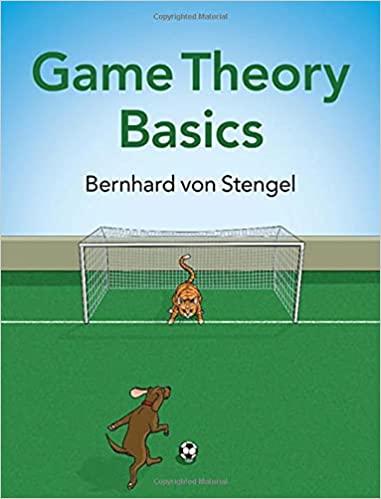Consider the bargaining problem of splitting a unit pie with utility functions (u, v:[0,1] ightarrow[0,1]) as
Question:
Consider the bargaining problem of splitting a unit pie with utility functions \(u, v:[0,1] \rightarrow[0,1]\) as in Exercise 11.4, that is, \(u(x)=x\) and \(v(y)=\) \(1-(1-y)^{2}\). Assume now that the bargaining behavior is described by the subgameperfect equilibrium of the standard alternating-offers bargaining game with \(k\) rounds. In round 1 player I makes a certain demand. If player II rejects this, she can make a certain counter-demand in round 2, and so on. A rejection in the last round \(k\) means that both players get nothing. The last player to make a demand is player I if \(k\) is odd, and player II if \(k\) is even. When agreement takes place in round \(i\) for some \(i\) with \(1 \leq i \leq k\), then the bargaining set has shrunk by a factor of \(\delta^{i-1}\). That is, the utility of what the players can get after each round of rejection is reduced by multiplication by the discount factor \(\delta\).
(a) Suppose that the number of rounds is \(k=2\). Draw the picture of shrinking bargaining sets (for some choice of \(\delta\) ) in these two rounds. Find the subgame perfect equilibrium, in terms of player I's demand \(x\), for general \(\delta\). What is the demand \(x\) when \(\delta=\frac{3}{4}\) ? What are the strategies of the two players in this subgame perfect equilibrium?
(b) Suppose that the number of rounds is \(k=3\). Draw the picture of shrinking bargaining sets in these three rounds. Find the subgame perfect equilibrium, for general \(\delta\), and compute the demand of player I in round 1 (you do not need to specify the players' strategies). What is player I's demand \(x\) when \(\delta=\frac{1}{4}\) ? (Then \(x\) happens to be a rational number.)
(c) Consider now an infinite number of rounds, and look for stationary equilibrium strategies, where player I demands the same amount \(x\) each time he makes a demand, and player II demands the same amount \(y\) every time she makes a demand. What is this demand \(x\) when \(\delta=\frac{3}{5}\) ? What is the demand \(x\) when \(\delta\) tends to 1? Compare this with the result of Exercise 11.4(b).
Exercise 11.4(b)
(b) Find the Nash bargaining solution. How will the pie be split, and what are the utilities of the players?
Step by Step Answer:






